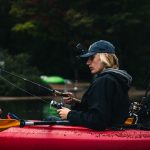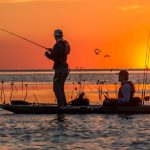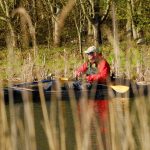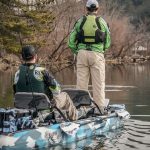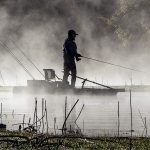Why the right size paddle board matters? From this guide you'll know everything necessary to find the paddle board best sized for you.
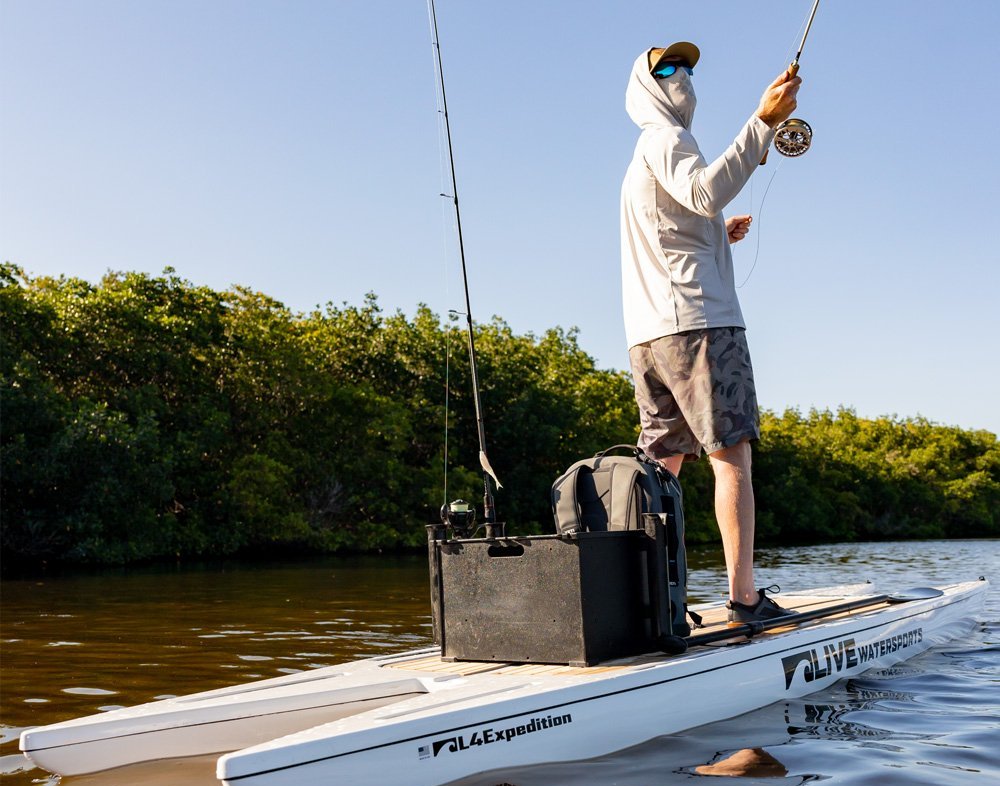
In a hurry? Our pick as the best fishing stand up paddle board is Bote Rackham Aero 12
Whoever had the brilliant idea to combine fishing and stand up paddle boards (two of the greatest activities in the world) was an absolute genius!
Paddle board fishing is a truly spectacular way to spend your summer days–floating around your favorite lake or river, casting out a line, and reeling in a fish or three to cook on the shore around your campfire.
I can think of few times that I’ve felt more relaxed and at peace than when I’m drifting along on my board waiting for the fish to bite.
If you’re considering getting into SUP fishing this year, you’ve come to the right place.
In this article, I’ll walk you through everything you need to know about choosing the right fishing SUP board (both hard-shell and inflatable paddle boards), examine the factors to consider when shopping for a fishing SUP, and even share some accessories that will make your next SUP fishing trip a whole lot more fun and comfortable.
Of course, this piece wouldn’t be complete without a list of recommendations of the best fishing paddle boards on the market. Each has been personally tested and thoroughly researched, so you can trust that they are your top pick!
As an affiliate of Amazon and other retailers, we may earn a small commission when you buy via our links, at no additional cost to you. Thank you!
Quick List: Best Fishing SUPs
Don’t have time to read the whole article? Don’t worry! Here’s a condensed list of all the fishing SUPs we recommend – you can always come back later to read the full reviews.
- Best Overall: Bote Rackham Aero 12
- Most Stable: Sea Eagle FishSUP 126
- Best Hybrid: Isle Switch 2-in-1 SUP
- Best Inflatable Runner-Up: Aqua Marina Drift
- Best With Motor: Bote Rover Aero Micro Skiff
- Best For Big Guys: Live Watersports L4
- Best Compact: Flycraft Mountain
- Best Budget: Atoll 11
Comparison Table: Best Fishing SUPs
| Model | Specs | Where To Buy |
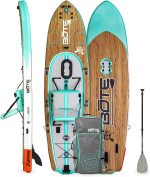 Bote Rackham Aero 12 | Size: 12’4″ x 38″ Weight: 45 lbs. Capacity: 400 lbs. | Amazon |
 Sea Eagle FishSUP 126 | Size: 12’6″ x 40″ Weight: 44 lbs. Capacity: 500 lbs. | Amazon |
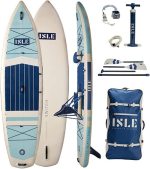 Isle Switch 2-in-1 SUP | Size 11’6″ x 35.5″ Weight: 19 lbs. Capacity: 425 lbs. | Amazon |
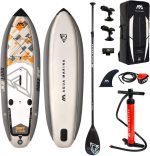 Aqua Marina Drift | Size: 10’10” x 38″ Weight: 36 lbs. Capacity: 286 lbs. | Amazon |
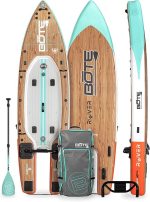 Bote Rover Aero Micro Skiff | Size: 12’6″ x 40″ Weight: 63 lbs. Capacity: 500 lbs. | Amazon |
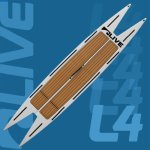 Live Watersports L4 | Size: 14′ x 34″ Weight: 65 lbs. Capacity: 700 lbs. | Live Watersports |
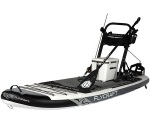 Flycraft Mountain | Size: 10’2″ x 33.5″ Weight: 25 lbs. Capacity: 275 lbs. | Flycraft |
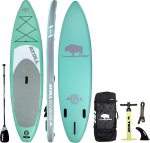 Atoll 11 | Size: 11′ x 32″ Weight: 21 lbs. Capacity: 500 lbs. | Amazon |
Top Paddle Boards for Fishing Reviewed
Best Overall: Bote Rackham Aero 12
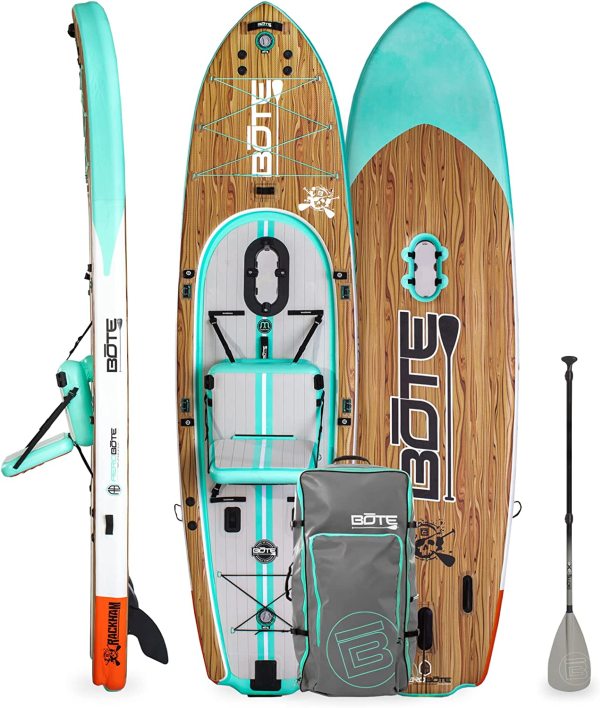
Length: 12’4″ (376 cm)
Width: 38″ (96.5 cm)
Weight: 45 lbs. (20.4 kg)
Weight Capacity: 400 lbs. (181.4 kg)
Bote is known for making some of the best paddle boards–not just paddle boards for fishing, but paddle boards, PERIOD.
The Bote Rackham Aero is an extra-long, extra-wide, and extra-stable board, perfect for anyone who wants to spend a long day out on the water. Not only does it feature an extra air chamber to add buoyancy and stability, but it also has multiple tie-downs and D-rings to secure attachments like rod holders, tackle racks, or a fishing rack.
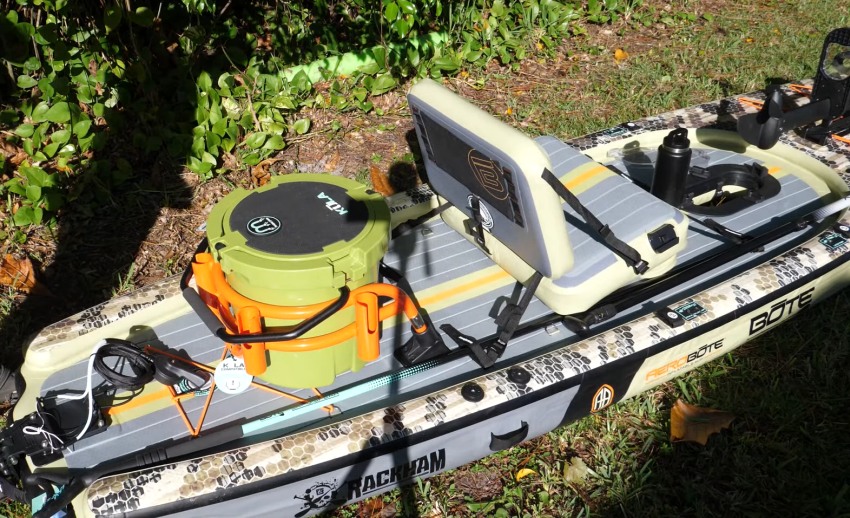
Its size and stability make it the ideal platform for casting out your line, and it’s one of the toughest, longest-lasting inflatable SUPs around.
Most Stable: Sea Eagle FishSUP 126
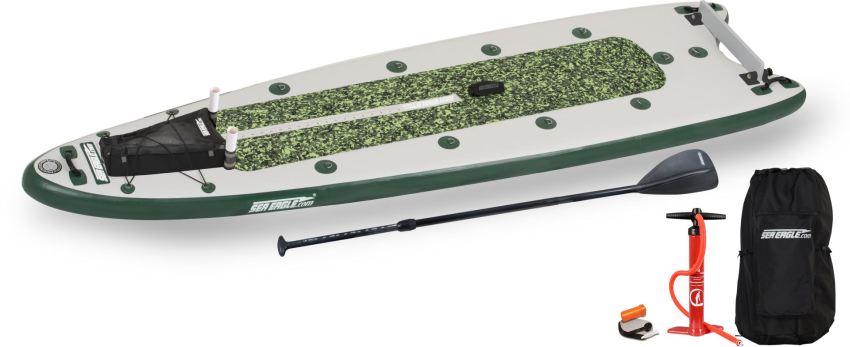
Length: 12’6″ (381 cm)
Width: 40″ (101.6 cm)
Weight: 44 lbs. (20 kg)
Weight Capacity: 500 lbs. (226.8 kg)
Sea Eagle is one of the top brands for inflatable fishing kayaks, so a fishing SUP from them is surely worth our attention. This particular Sea Eagle SUP is built specifically for fishing, with extra length (12.5 feet) and width (40″) to ensure it’s as stable as possible.
The 1100 Decitex reinforced drop-stitched board is incredibly sturdy, puncture-resistant, and abrasion-resistant. Not only does this Sea Eagle SUP include multiple D-rings that serve as attachment points for fishing rod holders, it even has an integrated trolling motor mount and a paddle pocket to store a backup paddle. And if you want to know exactly how large your fish was, the board even includes a fish ruler integrated right into the deck.
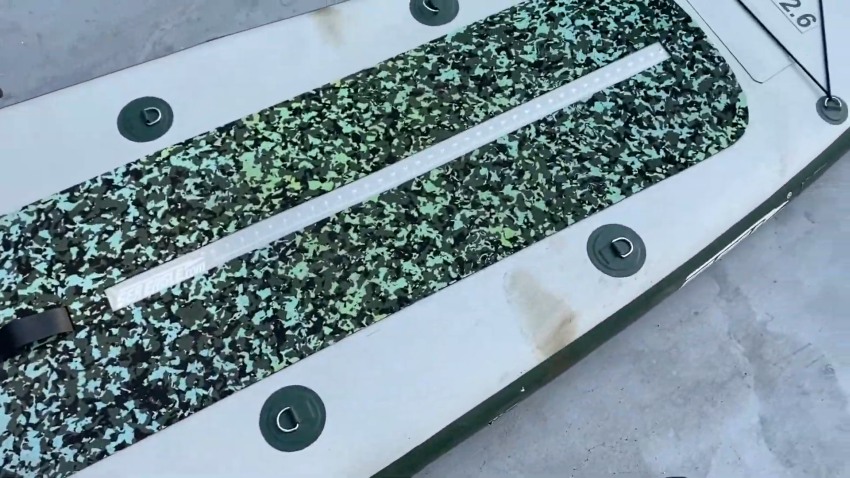
The basic package includes the bare essentials (including repair kit, paddle, backpack, and pump), but Sea Eagle offers more complete accessory packages for a higher cost.
Best Hybrid: Isle Switch 2-in-1 SUP

Length: 11’6″ (350.5 cm)
Width: 35.5″ (90.2 cm)
Weight: 19 lbs. (8.6 kg)
Weight Capacity: 425 lbs. (192.8 kg)
For anyone who wants to alternate between kayaking and paddleboarding, this is a truly great paddle board for fishing.
The ISLE Switch is built to be convertible between a SUP and a kayak. It comes with an inflatable seat and footrest that can easily be adjusted and offers a perfect balance between stability and maneuverability.
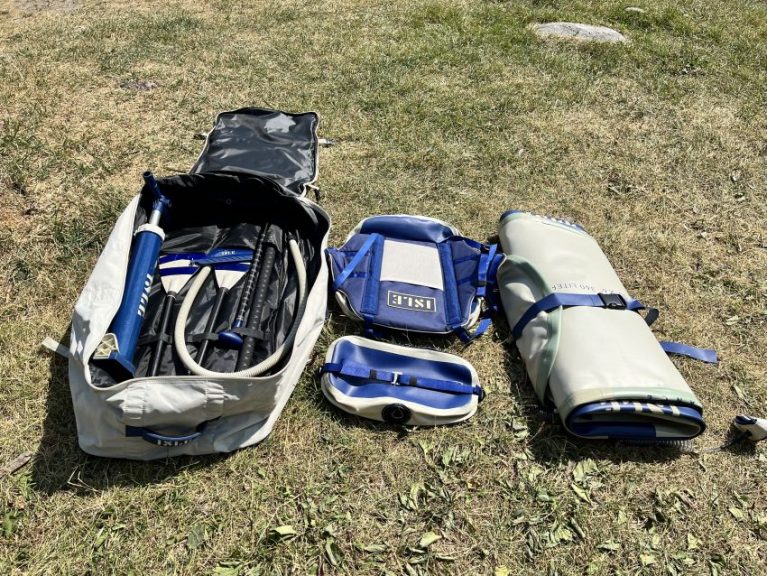
It’s easily as tough as the Bote/Sea Eagle models, but far more agile. You’ll find it gets amazing speed in both kayak and SUP configuration, great for paddling long distances upstream and still being comfortable for a long day of fishing.
Sadly, it doesn’t include any integrated fishing rod mounts, so you may have to glue mounts on yourself if you want to add holders. And there’s no way to add a trolling motor, fishing rack, or any more advanced fishing accessories.
(Read more about why this is a great all-around paddle board hybrid in my Isle Switch review)
Best Inflatable Runner-Up: Aqua Marina Drift
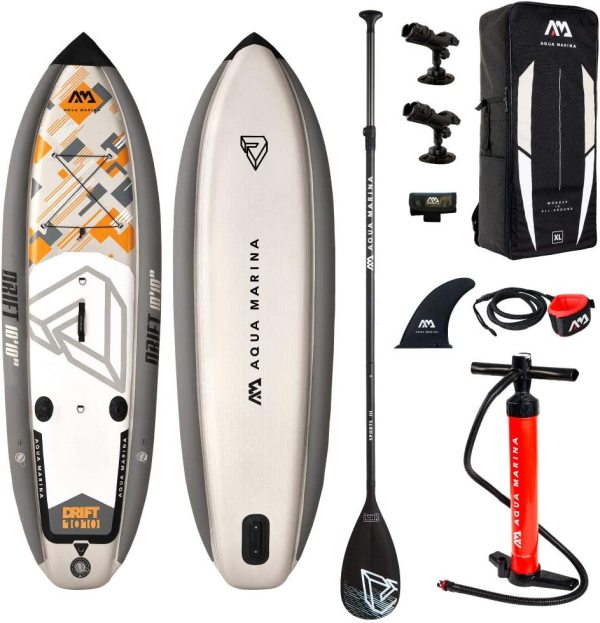
Length: 10’10” (330 cm)
Width: 38″ (96.5 cm)
Weight: 36 lbs. (16.3 kg)
Weight Capacity: 286 lbs. (130 kg)
The Aqua Marina Drift is one of the popular budget-friendly models of fishing SUPs. It’s purpose-built for fishing, with drop-stitch construction and a dual-sided air chamber that prevents deflation and guarantees maximum buoyancy and stability. It serves as a great casting platform and won’t tip or wobble even if you’re struggling to reel in a big one.
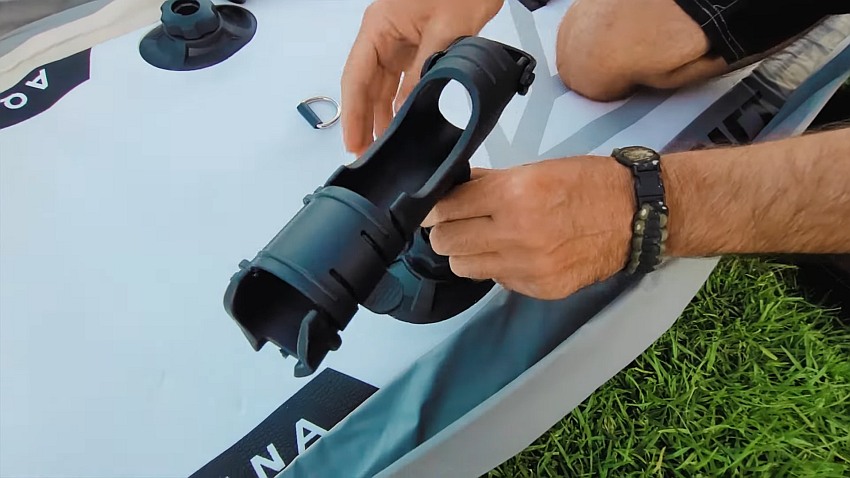
One thing a lot of anglers love about the Aqua Marina Drift is that it features two rod holders built right into the deck, as well as a bungee cord and multiple attachment points to secure a seat or cooler.
Thanks to the full-length deck pad, you’ll have excellent traction even if the deck gets wet.
For the price, the Aqua Marina Drift is easily one of the top-rated fishing SUPs around.
Best With Motor: Bote Rover Aero Micro Skiff
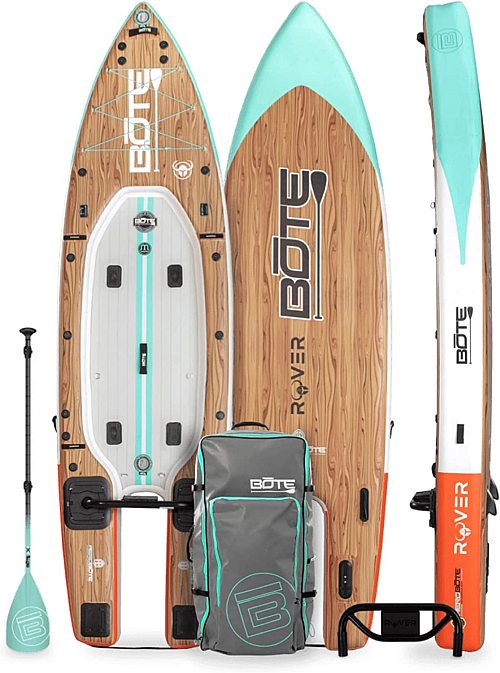
Length: 12’6″ (330 cm)
Width: 40″ (101.6 cm)
Weight: 63 lbs. (28.6 kg)
Weight Capacity: 500 lbs. (226.8 cm)
If you’re looking for a paddle board that’s compatible with a small outboard motor, this particular Bote model is just what you need. Included in the package is a Motorac (and necessary mounts) that serves as a mounting point for any fishing motor.

The board is purpose-built for fishing, with multiple D-rings and attachment points, bungee cord storage, and gear mounts. You can add up to two rod holders (or more) easily. It’s also beautifully stable and won’t tip over no matter how much the fish on your hook struggles.
Best For Big Guys: Live Watersports L4
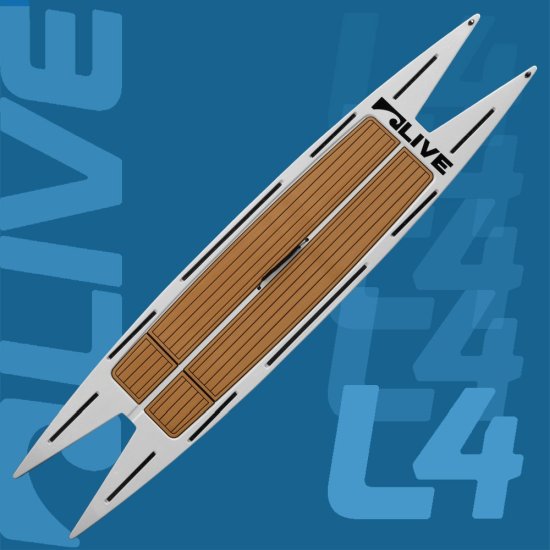
Length: 14″ (426.7 cm)
Width: 34″ (86.4 cm)
Weight: 65 lbs. (29.5 kg)
Weight Capacity: 700 lbs. (317.5 kg)
With a 700-pound weight capacity, this 14-footer is sized beautifully to handle even the heaviest paddler plus all the gear you could want to bring aboard. It’s got plenty of deck space so you can move around, change positions, or wrestle with a tough fish, and its extra length makes it one of the most stable fishing kayaks around.
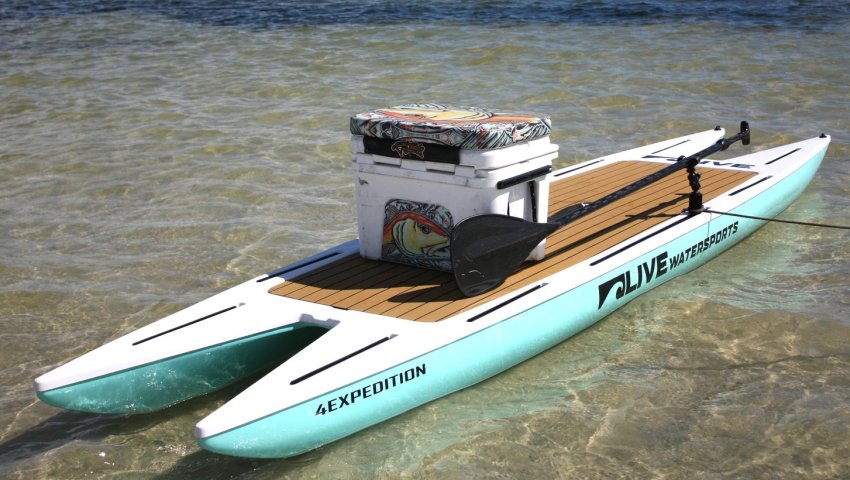
However, you’ll love that it’s fairly narrow for a fishing paddle board (just 34″ wide), so it covers great distances at impressive speeds. The catamaran style makes paddling a whole lot easier, making this the ideal paddle board for anyone who needs to head more than a mile or two upriver.
Sure, the initial investment is high, but the payoff is absolutely worth it.
Best Compact: Flycraft Mountain
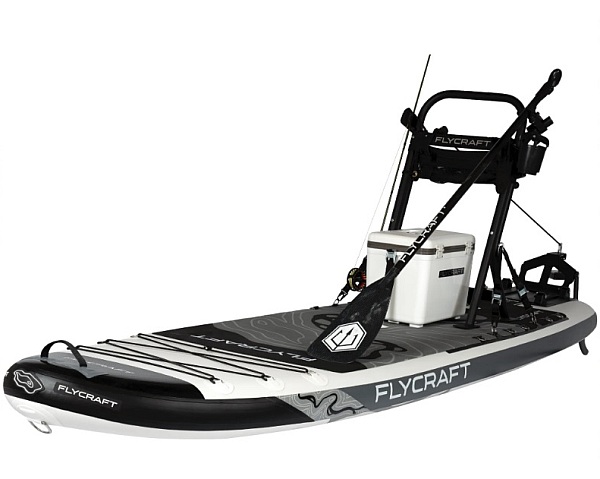
Length: 10’2″ (315 cm)
Width: 33.5″ (85 cm)
Weight: 25 lbs. (11.3 kg)
Weight Capacity: 275 lbs. (124.7 kg)
For those who prefer a more compact SUP, this is the pick for you. At just over 10 feet long and 33 inches wide, it’s slim, sleek, and fairly speedy compared to the average fishing SUP. It does sacrifice a bit of stability, so it may be a better choice for more experienced anglers and paddleboarders.
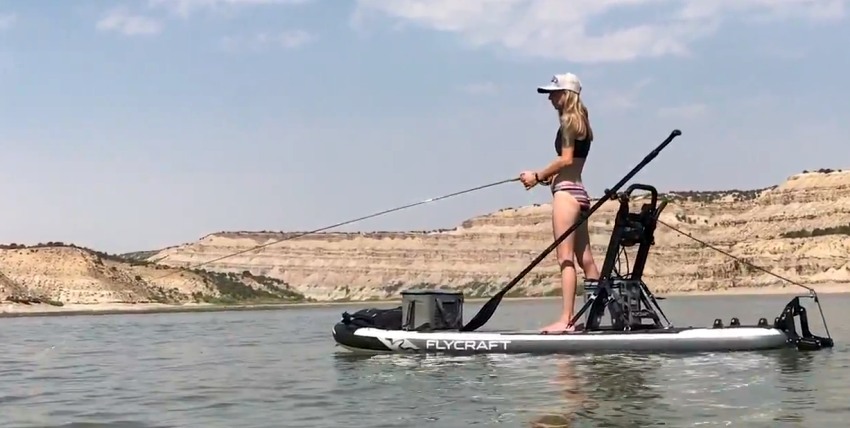
The board has everything you need for a full day of fishing: a full-length deck pad, multiple D-rings and attachment points, and the option to upgrade to a gravity fin, anchor system, and fishing rack.
Though it’s lightweight, it’s got a less-than-ideal weight capacity (just 275 pounds), so it’s better-suited to smaller paddlers.
Best Budget: Atoll 11
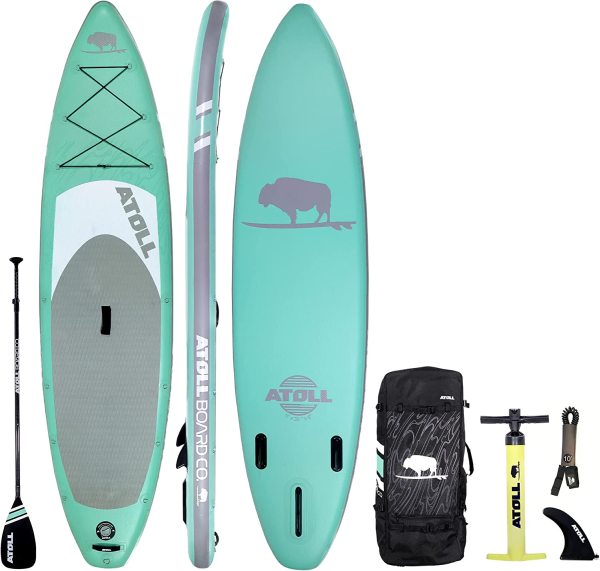
Length: 11′ (335.3 cm)
Width: 32″ (81.3 cm)
Weight: 21 lbs. (9.5 kg)
Weight Capacity: 500 lbs. (226.8 kg)
If you’re looking for a good first fishing SUP, the Atoll 11 is your budget-friendly pick. Though it’s the cheapest on our list (around $600, plus optional accessories), it’s still sturdy and rugged enough (made from drop-stitched PVC) to stand up to all your fishing adventures. It’s also purpose-built for fishing, with 15 reinforced D-rings around the deck to serve as attachment points for mounts, racks, and paddle holders.
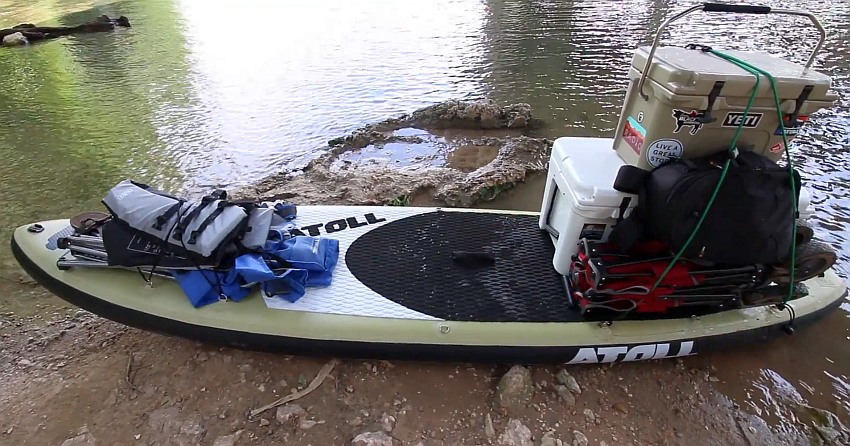
The board has a great weight capacity (500 pounds) but weighs just 21 pounds, making it beautifully portable. Despite its standard size and width, it’s surprisingly stable and makes a good casting platform.
Complete Guide to Choosing the Best Fishing Paddle Board
Below, we’re going to walk you through everything you need to know to choose the best fishing paddle board for you to take out on your favorite lake, river, or even into the ocean. By the end of this post, you’ll have no trouble picking out a fishing SUP (plus handy SUP fishing gear) necessary to make for a truly spectacular summer.
Why Use a Fishing Paddle Board Specifically?

I want to make one thing clear: you can go fishing from a lot of different paddle boards, not just a fishing paddle board.
Recreational paddle boards, Yoga SUPs, and even surf SUPs can be used for paddle board fishing in a pinch.
But it’s important to know that though they can be used for fishing, they’re not the best choice. Why is that?
Simple: they’re designed for other activities, not specifically fishing.
Recreational paddle boards are usually designed to be a bit shorter, narrower, and more sluggish than fishing paddle boards. After all, they’re largely used by newbies who are new to paddle boarding and need higher primary stability.
Yoga SUPs are crafted for maximum stability, meaning they’re extra-long and extra-wide. They’re much harder to paddle upriver or maneuver to your fishing hole.
Surfing SUPs are short and built for catching waves, meaning they have excellent secondary stability but the primary stability necessary to keep you steady as you fish standing up just isn’t there.
With fishing SUPs, you’ve got a paddle board purpose-built for fishing. Your average fishing SUP board will be a bit longer and wider than your average recreational paddle board, designed for maximum primary stability. They’re crafted to be stable and steady when fishing standing up. Many feature a deck pad that provides support and improves circulation over long hours of standing up (think of those anti-fatigue desk mats used by office workers at standing desks).
Inflatable fishing paddle boards are also crafted using tougher materials that won’t puncture or tear if you accidentally sink a hook into the deck or sides. They’ll also be built with fishing-specific mounts, rod holders, D-rings, and other accessories (as you’ll see below).
All in all, a fishing SUP is the best choice because it’s built specifically to make your time out fishing as comfortable and effortless as possible.
Inflatable vs. Hard-Shell Paddle Boards
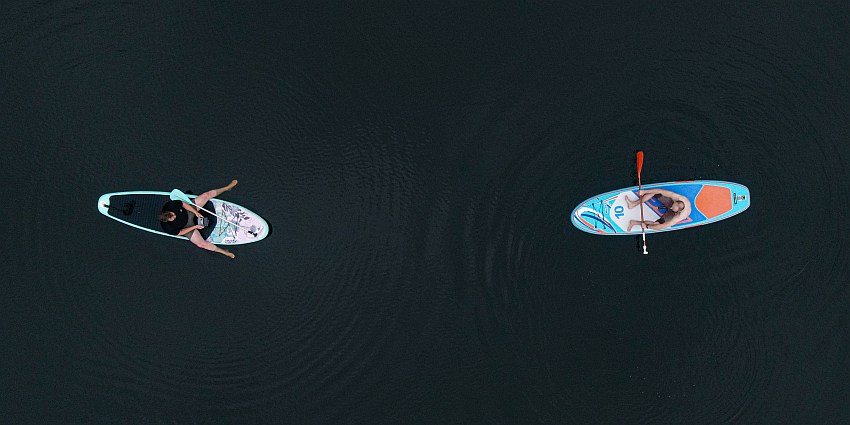
As you saw in our list above, most fishing SUPs are inflatable paddle boards. This is for a number of very good reasons (which we’ll expound on below).
However, you can find a number of hard-shell fishing paddle boards, too. It’s important to understand what situation is best to use a hard-shell fishing SUP, and which will be better for an inflatable fishing SUP.
Inflatable Fishing Paddle Board Pros:
- Extremely portable. It fits into a backpack-sized bag and can be transported in the trunk of any car or even on public transportation.
- Excellent primary stability and buoyancy. Due to the air filling it, an inflatable fishing SUP will be very unlikely to tip over.
- Fairly inexpensive. You can find a lot of inflatable fishing paddle boards retailing at affordable prices, cheaper than the hard-shell models.
- Great for newbies. Heading out on your first paddle board fishing trip will be much easier with an inflatable fishing SUP.
Inflatable Fishing Paddle Board Cons:
- Less durable. There is some minor risk of the inflatable paddle board getting punctured by a hook or some underwater obstacle.
- Not as performance-oriented. A hard-shell fishing paddle board tracks and handles better, can get better overall speeds, and will be better suited to coastal waters than an inflatable paddle board.
Hard-Shell Fishing Paddle Board Pros:
- Well-suited to handling strong currents and ocean waves. Hard-shell paddle boards tend to have a sturdier structure less likely to bend or sag, providing greater stability on uneven and rough waters.
- Go places faster and more efficiently. Hard-shell paddle boards track straighter, handle better, and move faster. You can get from your launch point to your fishing hole much faster than with an inflatable paddle board.
- Significantly more durable. Hard-shell fishing SUPs can withstand a lot of damage, impact, and hard use. Expect to get at least 10+ years out of your hard shell board.
Hard-Shell Fishing Paddle Board Cons:
- More expensive. The cost of a hard-shell fishing paddle board is at least 25% more than an inflatable paddle board, though you can find the prices rise to as much as 100% higher.
- Less portable. You must have a vehicle or trailer to haul your fishing paddle board, otherwise you’re not going anywhere.
Both hard-shell and inflatable stand-up paddle boards are good options to consider. In the end, it’s all about what matters most to you, and which will make your fishing trip more comfortable and enjoyable.
Factors to Consider for the Best Fishing Paddle Board
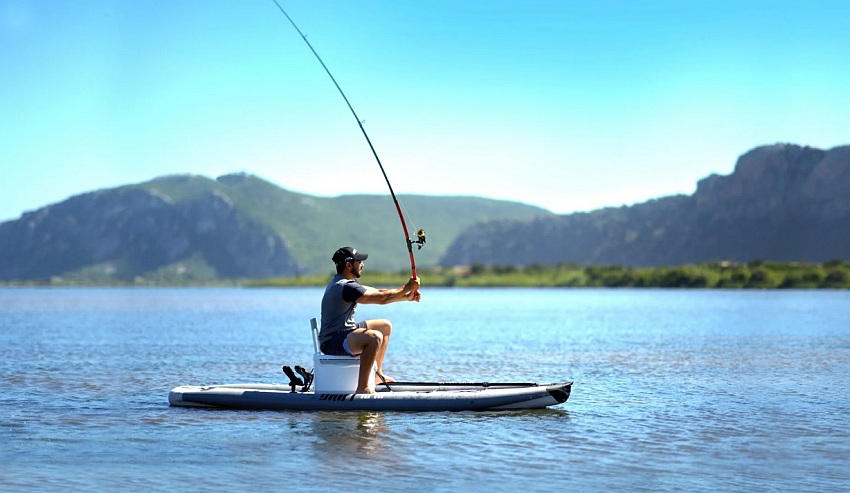
Stability
Think about it: if you’re going to wrestle with a fish, the last thing you want is a tippy board likely to flip over at the wrong time. Stability is the most important factor to consider when looking into the best fishing paddle board.
Stability is dictated by three factors:
Factor #1: Width
Wider paddle boards are more stable because there is more surface area in contact with the water’s surface.
Factor #2: Length
A longer board also occupies more space on the water. More surface area in contact with the water’s surface creates a more stable “platform” to fish from.
Factor #3: Thickness
The thickness of the paddle board is also important when looking at inflatable stand up paddle boards. A thicker board has more volume, and more volume means greater buoyancy and stability.
When shopping for a fishing SUP, you want to look for a paddle board that’s slightly wider and longer than a recreational board, but not quite as long or wide as a Yoga SUP. That way, you get good stability without sacrificing your maneuverability entirely.
Weight Capacity
Weight capacity matters for one simple reason: the more weight the fishing paddle board can hold, the more fishing gear you can bring along!
The weight capacity of a fishing SUP has to include not only you, the paddler, but also the weight of all your fishing gear: accessories, coolers, bait and tackle boxes, fishing rods, and any other fishing equipment you’re bringing with you.
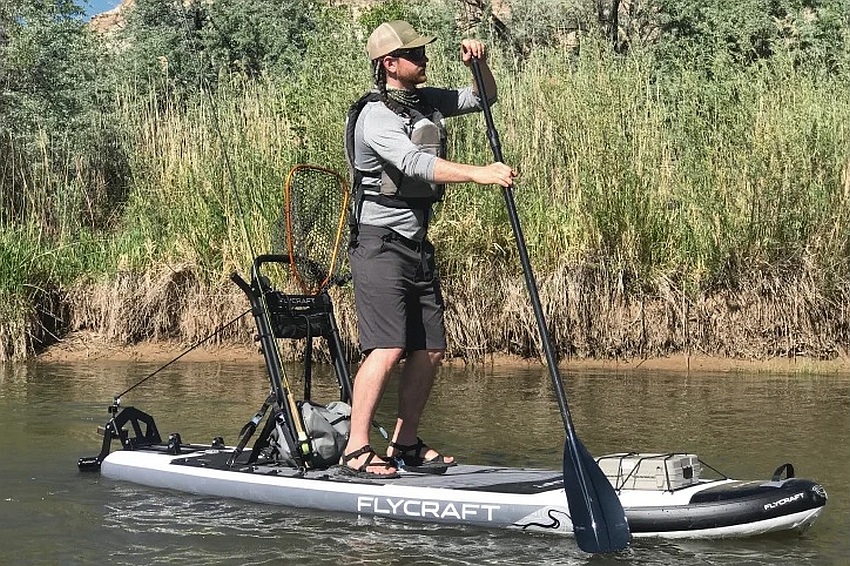
For smaller, lighter paddlers, finding a fishing paddle board with sufficient weight capacity is no great challenge.
For bigger, heavier paddlers (like myself, at a cool 250 lbs.), it can be tough to find a paddle board that can handle my weight along with the weight of all my fishing gear, too. It’s absolutely necessary to find the best fishing SUP with a high enough weight capacity to accommodate your weight with plenty of pounds to spare.
Weight
The weight of your fishing paddle board matters for its portability and transportability.
If the fishing SUP is excessively heavy, you may struggle to carry it to and from the water, load and unload it from your roof rack or trailer, and take it in and out of storage. You’ll be too tired to enjoy your fishing trip because all of your energy is going into hauling your stand up paddle board.
That’s why so many of the best fishing paddle board models around are inflatables. Inflatable stand up paddle boards are light and easy to carry to and from the water. The fact that you can throw them into the trunk of any car (no need for a roof rack) is just an added bonus. They’re definitely a highly portable solution, great for SUP fishing on a weekday or packing for a car camping and fishing trip.
Deck Pad
Deck pads serve three critical purposes:
Purpose #1: Cushioning
Fishing for long hours on your knees can be very uncomfortable if there is nothing between you and the solid, rigid structure of your paddle board. A good fishing stand up paddle board will include a deck pad to provide a layer of cushioning that makes hours of fishing on your knees and/or on your feet a whole lot more comfortable.
Purpose #2: Support
Standing up for long hours can lead to foot fatigue, as well as poor circulation. The problem is, you can’t really move around a whole lot because you’re standing out in the middle of the water. Any excessive movements could cause your paddle board to tip over.
Deck pads are added to a stand up paddle board to serve a function similar to the anti-fatigue mats you’ll see cashiers at supermarkets or office workers at a stand-up desk use. They’ll make your fishing adventure more comfortable by providing good foot support to reduce fatigue and improve circulation.
Purpose #3: Traction
Last, but definitely not least, there’s the grip factor. Most fishing paddle boards feature a grippy rubber or foam deck pad that give your feet something to grip onto when you are standing up. That way, you can set your feet and brace your legs to reel in a stubborn fish without worrying about slipping and sliding on the deck of your board.
A full-length deck pad isn’t just a nice-to-have; on a fishing SUP board, it’s a must-have!
Fishing Gear Mounts/Attachment Points
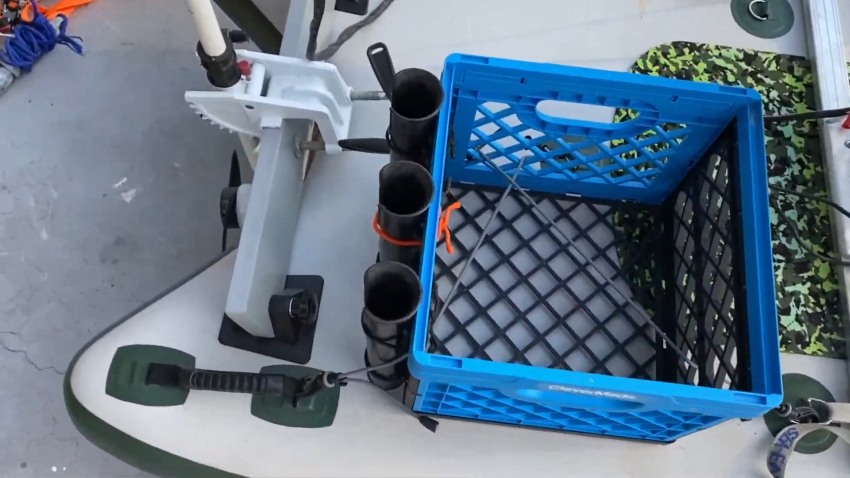
You can’t hold both your paddle and your fishing rod at the same time. You need to have somewhere to place one while using the other.
For paddle board fishing, gear mounts are an absolute necessity. You need a paddle keeper to store the paddle while fly fishing, then rod holders to store your fishing rods while you’re paddling or trolling along.
Stand up paddle boards designed specifically for paddle board fishing will usually feature more D-rings than recreational boards. This provides you with places to secure accessories like rod holders and paddle holders. Some will feature Scotty mounts and action mounts, both of which are compatible with fishing-specific accessories.
Paddle boards for fishing may also be built specifically with a trolling motor mount attachment point, similar to the attachment point integrated into a fishing kayak.
Seat
I know it’s called a “stand up paddle board”, but that doesn’t mean you have to stand up all day long. Sometimes it’s nice to sit and relax on your fishing board while you’re waiting for the fish to bite.
The best fishing paddle boards will either include a comfortable seat (complete with lower back support and a foot rest) or at least include the anchor points to add a seat together with your other fishing accessories.
Warranty
The best fishing paddle board will be backed by a good warranty, proof that the manufacturer believes that their product is sturdy and built to last.
For hard-shell fishing paddle boards, the warranties will usually be upwards of 3-5 years–some as long as 10 years.
Inflatable SUP fishing boards, however, may only be backed by a warranty of 1-2 years (for the cheaper brands), though some of the best fishing paddle boards produced by the top-rated manufacturers will offer a warranty of 5+ years.
Steer clear of any SUP fishing board that only offers a 90-day or 6-month warranty. A stand up paddle board like that is not built to last!
Price
Price isn’t the most important factor to consider when shopping for fishing paddle boards, but it’s still worth taking it into account when weighing up all your options.
Inflatable stand up paddle boards tend to be cheaper than hard-shell SUP fishing boards because the materials used in their construction cost less. Hard-shell paddle boards also are more labor-intensive to construct.
If you’re trying to keep under budget, an inflatable stand up paddle board is a great choice. For anyone who’s never tried paddle boarding (much less paddle board fishing), a low-cost inflatable SUP fishing board is a great first-time buy.
However, bear in mind that the hard-shell fishing SUP boards will last longer. More experienced SUP anglers may want to consider investing in a fishing SUP that will serve them for 10+ years and stand up to much harder use, even if that means paying a higher price.
Handy Fishing SUP Accessories You’ll Need
Accessories can make your SUP fishing trips a whole lot more comfortable, not to mention a whole lot safer. Below are the fishing SUP accessories you should always take out on the water with you:
PFD
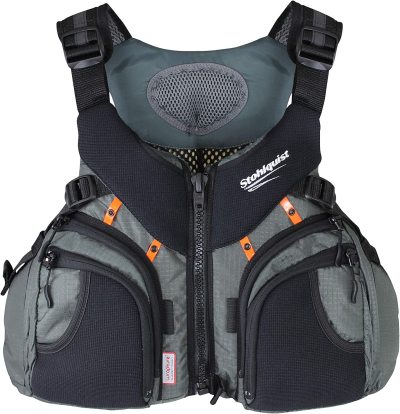
The U.S. Coast Guard requires you to use a Personal Flotation Device when paddle boarding. But it’s not just about the legality; it’s also the safer and smarter choice to wear a PFD, as you’ve got a greater chance of survival should something happen to you or your board when out SUP fishing.
Paddle
You can’t go paddle boarding without a paddle–it’s even right there in the name!
A cheap aluminum paddle with a plastic paddle head is a great fallback in case your main adjustable paddle gets lost or broken. You can keep one in a paddle pocket as a backup.
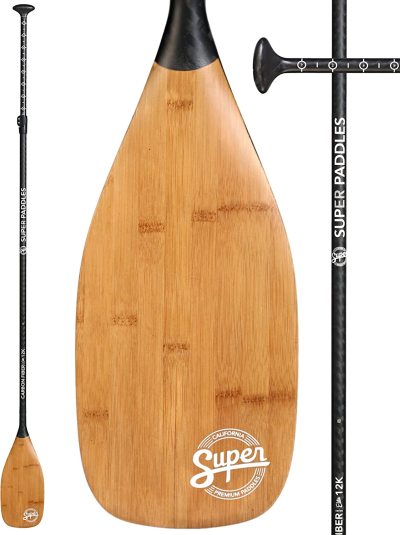
However, more experienced SUP fishing enthusiasts will likely want to upgrade to a dedicated fishing SUP paddle made out of carbon fiber or fiberglass. Though pricier, a higher-quality adjustable paddle will enable you to cover distance much faster, and will reduce the effort required to propel yourself along.
Leash
Many stand up paddle boards include a leash, which tethers you to your board so it won’t drift away and leave you stranded in the middle of the lake. When paddle boarding, always make sure the leash is in good condition and properly secured to your ankle or calf before heading out on the water.
Electric Pump
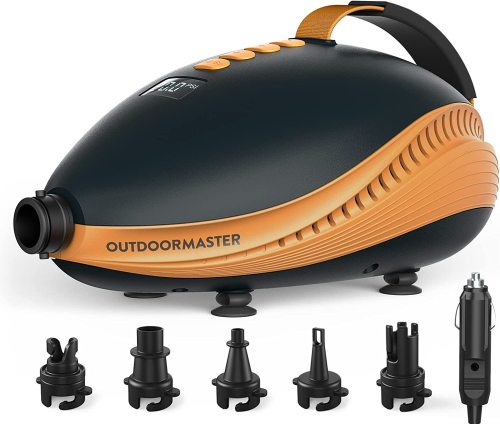
An electric high-pressure pump is a must-have for inflatable SUPs. You can waste a lot of time and effort pumping up your board by hand or using the foot pump. That will also mean less time to spend on the water and greater fatigue before you ever cast out your life.
If you’re using an inflatable paddleboard, I strongly recommend getting an electric high-pressure pump. It plugs into your car’s 12V power socket and does the work of inflating your board (and your inflatable seat and footrest, if you have those) instead of you.
Fishing Cooler
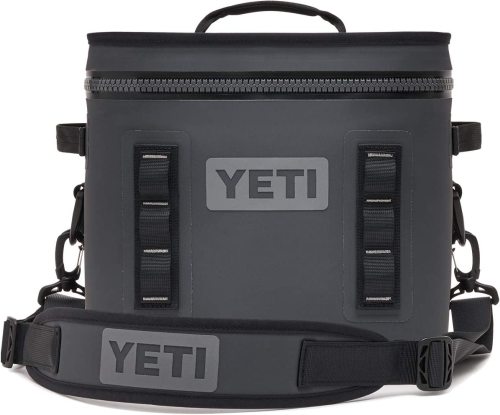
Fishing coolers are a must-have for two reasons:
- Your Food and Drink
A long day of SUP fishing is made a whole lot more enjoyable with a few drinks and some food (or snacks) to keep you hydrated and satiated. A small drinks cooler ensures your beverages stay cold all day long.
- Your Catches
You don’t want the fish you keep to go bad on a hot day. A cooler is a great way to store your catch that will also make sure your catch stays fresh. Even better, a cooler doubles as a seat, making your fishing adventure much more comfortable.
You may need to buy specific tie-downs or additional bungee cord to secure a cooler to your deck. But if you’re serious about catching fish on your SUP, it’s a smart investment into a proper fishing setup.
Fishing Rod Holders
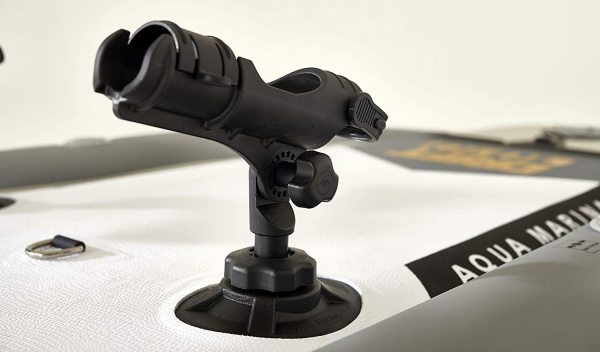
Rod holders are a must-have for any serious angler.
As I explained above, fishing rod holders provide you with a place to store your rod while you’re paddling (just like you’d use paddle holders to keep your paddles secure while you’re fishing).
Any good paddle board for fishing will include some sort of mount for rod holders, though what type of mount will vary from brand to brand.
Some hard-shell paddle boards for fishing will include pre-mounted rod holders, or at the very least, points where you can add screw-in mounts. Others may feature Scotty mounts or other mount types glued to the deck, providing you a secure place to add in your rod holders.
Anchor
Of all your fishing accessories, none is quite as underrated or so often forgotten as an anchor.
An anchor (or a sand spear if you’re fishing in shallow waters) will keep you from drifting along with the current or tide, ensuring you stay securely in place while casting out your line. If you’ve got a favorite fishing spot or you know where the fish are biting, having an anchor ensures you stay right at that spot all day long.
This is one of those SUP fishing tips I learned years ago, and which I share with everyone I meet. It just makes SUP fishing so much easier!
Fishing SUP FAQs
Most dedicated fishing SUP board models will be in the 11 to 12.5-foot range. For your fishing adventures, you’ll find a longer, slightly wider board provides better stability so you can maintain your balance while fishing both standing up and sitting down.
Most anglers find the best paddle boards for fishing are inflatable because inflatable SUPs have higher weight capacity and primary stability than the average solid paddle board. However, there are a number of hard-shell boards designed specifically for fishing that will last longer and perform better than a budget-friendly inflatable board, even a dedicated fishing SUP. If you’re willing to spend a bit more to get the best paddle board for fishing, you will find a solid board is a wiser long-term investment than inflatable SUPs.
When you’re entirely focused on trying to catch fish, you don’t really need to worry about maneuverability. Really, you’ll spend more of your time staying in the same spot or paddling against gentle currents. You won’t need more than a single removable center fin on a paddle board for fishing.
This is one of those paddle boarding and fishing tips you should learn in order to be a smart, safe angler. Traffic along the river flows the same as traffic along the street, meaning you should always paddle on the right-hand side of the river to avoid collisions with vessels, kayaks, and paddle boards heading the other way.




